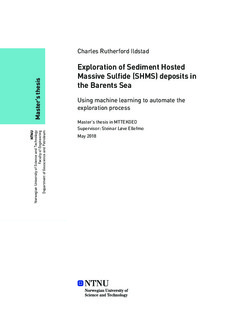| dc.contributor.advisor | Ellefmo, Steinar Løve | |
| dc.contributor.author | | |
| dc.date.accessioned | 2019-05-25T14:00:54Z | |
| dc.date.available | 2019-05-25T14:00:54Z | |
| dc.date.issued | 2019 | |
| dc.identifier.uri | http://hdl.handle.net/11250/2598831 | |
| dc.description.abstract | Barentshavets geologi hjemmer flere hydrokarbonreservoarer, som gjør den til en økonomisk viktig del av norsk sokkel, og er tidligere blitt grundig undersøkt på grunn av dette. I denne oppgaven blir regionen utforsket med bakgrunn i en ny økonomisk ressurs, nemlig sedimentbaserte, massive sulfidforekomster(SHMS), og en konkret letestrategi er presentert. I tillegg undersøkes nye måter å automatisere trinnene i leteprosessen på, og en ny maskinlæringsalgoritme for automatisering blir foreslått.
Resultatene viser at Barentshavet inneholder de nødvendige genetiske komponentene for en rekke SHMS-forekomster, med Sedimentære Exhalative(SEDEX) - Mississippi Valley Typer(MVT) foretrukket på grunn av utbredelsen av karbonater og mangel på vulkanisme. Den mest sannsynlige typen, basert på funn, er sen-permisk til tidlig-triassisk Irish Valley Type(IVT)-forekomster i nærheten av Leirdjupet-forkastningskomplekset i Bjørnøya-bassenget.
En ideell letestrategi for slike forekomster inkluderer magnetiske, gravimetriske, elektromagnetiske og
seismiske data, og detekterer mineralforekomsten både direkte og indirekte. På grunn av datatilgjengelighetsbegrensninger ble utforskningsstrategien utelukkende basert på seismiske data og besto av direkte deteksjon ved seismisk amplitudeanalyse, så vel som indirekte deteksjon ved omfattende datavisualisering og tolkning.
Til slutt ble en maskininnlæringsmetode kalt et 3D-konvolusjonelt neuralt nettverk(CNN) brukt for å automatisere både kartlegging av vertsbergart og forkastningsdeteksjon i seismiske data. Resultatene fra denne algoritmen viste gode resultater, og ytterligere forbedringer, samt andre potensielle bruksområder, ble foreslått. | |
| dc.description.abstract | The geology of the Barents Sea has previously been extensively studied, and shown to hosts several hydrocarbon reservoirs, making it an economically important part of the Norwegian continental shelf. In this thesis, the region is explored in terms of a new economical resource, namely Sediment Hosted Massive Sulfide(SHMS) deposits, with a concrete exploration strategy presented. In addition, novel ways to automate the steps in the exploration process are investigated and a new machine learning algorithm for automation is suggested.
The results show that the Barents Sea contains the necessary genetic components for a whole range of SHMS deposits, with the Sedimentary Exhallative - Mississippi Valley Types favoured, due to the prevalence of carbonates, and scarcity of volcanics. The most likely type, based on exploratory findings, are Late-Permian to Early-Triassic Irish Valley Type deposits in the vicinity of the Leirdjupet fault complex in the Bjørnøya basin.
An ideal exploration strategy for such deposits includes magnetic, gravimetric, electromagnetic, and seismic data, and targets the mineral deposit both directly and indirectly. Due to data availability constraints, the exploration strategy utilized was exclusively based on seismic data and consisted of direct detection by seismic amplitude analysis, as well as indirect detection by comprehensive data visualization and interpretation.
Finally, a machine learning method called a 3D-Convolutional Neural Network was used for automating both the mapping of host rock and fault detection from seismic data. This algorithm showed promising results and additional ways to improve on it, as well as other potential applications, are suggested. | |
| dc.language | eng | |
| dc.publisher | NTNU | |
| dc.title | Exploration of Sediment Hosted Massive Sulfide (SHMS) deposits in the Barents Sea | |
| dc.type | Master thesis | |
